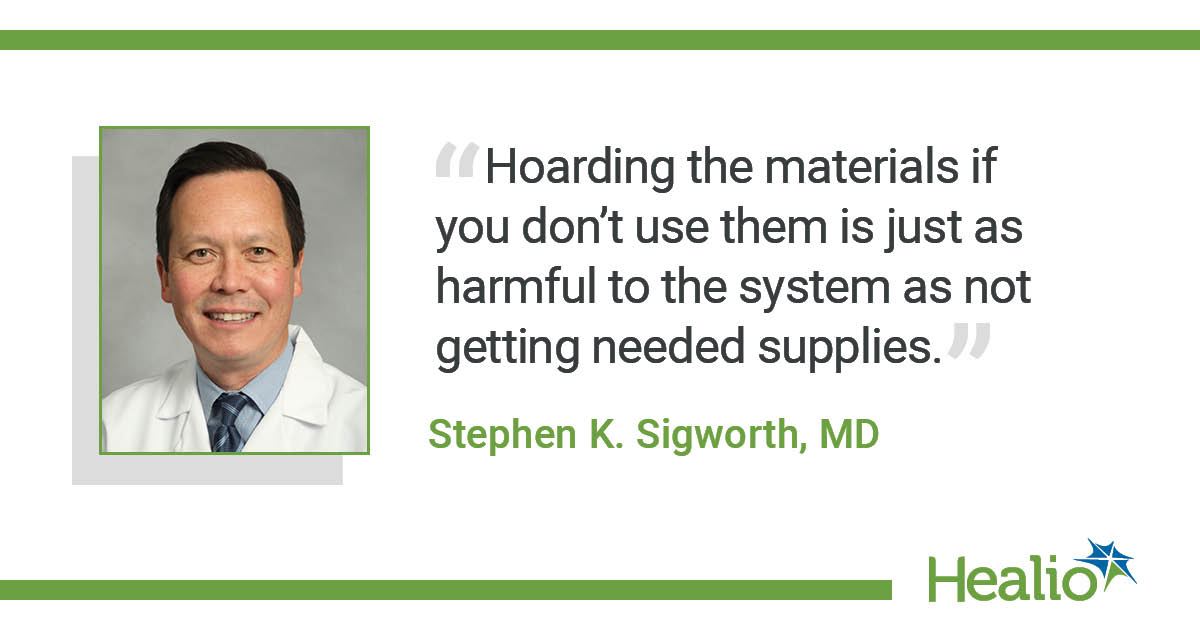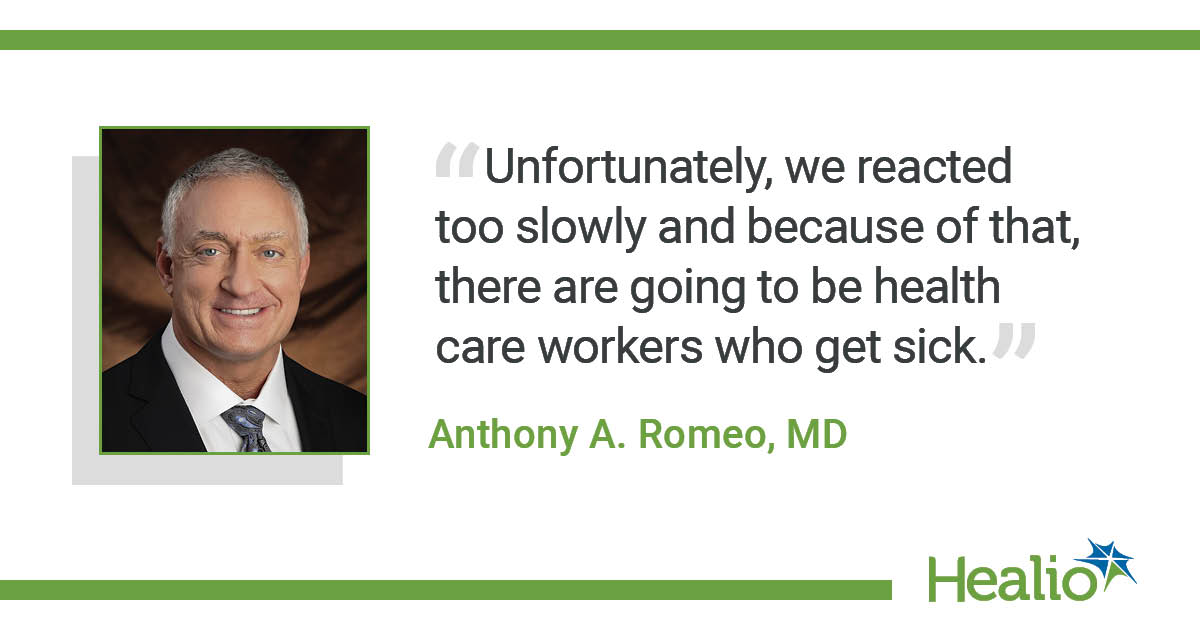Preparing for surge capacity during COVID-19 pandemic
As the COVID-19 pandemic escalates in the United States, concerns have grown about the strain that the inevitable increase in patients will cause to the nation’s health care system.
In New York, one of the hardest-hit states, Governor Andrew Cuomo announced that hospitals should have a goal to increase their capacity by 100%.
“We understand many hospitals won’t be able to do it,” Cuomo said during the announcement. “However, at a minimum, hospitals must give us a plan to increase capacity by at least 50%.”
As hospitals and practices alike work to increase their capacity so they can treat as many patients as possible, the nation is experiencing shortages of essential supplies, including personal protective equipment (PPE).

Healio Primary Care spoke with experts to learn more about what primary care physicians (PCPs) can do to expand the capacity of their practices, handle increasing workloads and manage the health implications of shortages caused by a strained health care system.
What PCPs can do to prepare
Stephen K. Sigworth, MD, an internist at Mount Sinai, Queens, recommended that PCPs designate certain rooms in their practices specifically for patients with suspected COVID-19 to help prevent them from potentially spreading the virus to other patients.
Another containment strategy primary care practices can use is to have patients with suspected COVID-19 visit in groups at the end of the day. Then, the practice can be thoroughly cleaned so that it is sterile and ready for patients without suspected COVID-19 the following morning.
Sigworth warned that the first time a PCP sees a patient with COVID-19 “can tend to cause a little disruption in your practice.”
“But by the 10th patient, it’s smooth sailing,” he continued. “As long as your staff has all the processes nailed down and committed to memory, so to speak, it just becomes regular patient care.”
As practices reach capacity, PCPs can help lower the number of patients visiting the office by encouraging those with a fever to call ahead of time and report their symptoms. This allows PCPs to determine who needs to visit the practice, who can be treated at home and who needs to visit the ED.
Sigworth also said that physicians in areas where infections are low should stay up to date on potential treatments for COVID-19 and the infection rate in their area, and those in areas where COVID-19 is prevalent should do this to help with “keeping your head above water.”
In terms of keeping practices well stocked, Sigworth recommended that physicians have frank discussions with their supply chain to determine what they need to stock up on, and what can wait for the next shipment.
He urged physicians not to hoard supplies, because “hoarding the materials if you don’t use them is just as harmful to the system as not getting needed supplies.”
‘We reacted too slowly’
Initial guidelines on PPE use from WHO and the CDC — which were based on responses to previous epidemics — state that health care workers should use PPE when treating patients who are symptomatic or had been exposed to confirmed cases, according to Anthony A. Romeo, MD, chief medical editor of Orthopedics Today and chief of orthopedics for Rothman Orthopedic Institute’s New York division.

However, this is problematic because “the global community of health care providers has revealed that this virus is uniquely different than influenza and other viruses,” Romeo told Healio Primary Care.
“Most importantly, a significant number of people are being infected by individuals who have no symptoms,” he said.
Romeo noted that observations of the COVID-19 pandemic in China and South Korea have shown that “so many people who are transmitting this disease do not know that they have it, so you have to act as if everyone you come in contact with has it, especially if you’re a health care worker.” Response efforts in these countries have also shown that the use of face masks and other PPE regardless of patient history and symptoms significantly reduces the risk for infection among health care workers. Despite this information, when the outbreak reached the United States, decisionmakers in health care systems stuck with WHO and CDC guidelines, according to Romeo.
“When administrative and business leaders realized they didn’t have [enough] PPEs, they stuck to the WHO and CDC guidelines and essentially let people go back to work, including on the frontline, without proper masks or PPEs,” he said. “Decisions were made not based on the first priority of the safety and the health of the health care workers, but instead on the availability of PPEs and the supply chain.”
In New York, once the virus was widespread throughout the community, leaders finally disregarded WHO and CDC guidance and recommended that all health care workers wear masks, Romeo said.
“So today in places like parts of California, where they have a major health care system that is not providing masks for their physicians, I would predict within 1 to 2 weeks that policy will change,” he said. “For me this is very sad because the information is not new. It has been very well documented internationally, and it should be a part of any health care providers’ proper clothing and garb during today’s pandemic.”
But the issue remains that the United States may not have enough supplies for all health care workers.
Romeo explained that much of the world’s supply of masks comes from China. When the outbreak escalated in the country, it “increased its mask production by more than 10 times and made sure all of their health care workers had masks.” Companies in China, including the American company 3M, are capable of further increasing mask production and transporting these masks to the United States within days, but proper negotiations through political channels — which are currently strained between the two countries — are needed, he said.
“The sad part is, none of this is unpredicted,” Romeo said, noting that the need for health care workers to wear PPEs was recognized months ago in China. “Unfortunately, we reacted too slowly and because of that, there are going to be health care workers who get sick, who are not properly protected, and there’s going to be some who are going to die.”
Taking action
In an effort to get more PPEs to health care workers and ensure the U.S. health care system can manage surge capacity, President Donald Trump signed an executive order to increase funding for supplies needed to test, treat and manage COVID-19.
The AMA supported the efforts, with President Patrice A. Harris, MD, stating that “the AMA has called for a ‘Manhattan Project’ type effort to expand manufacturing capacity and produce supplies needed in this time of national emergency, and this Executive Order will help bolster the supply of PPEs, ventilators, and tests to help with diagnosis.”
In another effort to increase PPEs, the ACP proposed improvements to the CARES Act, asking Congress to do everything possible to ensure all health care workers caring for patients who may have COVID-19 to have access to PPEs.
The organization’s additions to the CARES Act would also require payers to cover telephone consultations between physicians and their patients, financial support to physicians and practices, increase Medicare and Medicaid payments for COVID-19 patients and expand Medicaid eligibility and coverage to ensure vulnerable populations can receive care.
“Such improvements must ensure that frontline physicians are supported in providing patients with the best possible care, that patients have access to needed care and are able to afford it, and that the United States has the capacity needed to address this growing national health emergency,” ACP President Robert McLean, MD, wrote in the letter to congress.
Blood supply
In addition to reduced medical supplies, the U.S. is also facing a shortage of blood donations.
The FDA released a statement explaining that blood donations have been dramatically reduced during the COVID-19 pandemic, and noted that “in order to ensure that blood is available to those who need it most, it is important for healthy individuals who are able to donate to take the time to do so.”

Robert Kessler, senior manager of Vitalant, a national transfusion medical organization, told Healio Primary Care that “not having enough blood to meet basic patient needs will cause another public health crisis.”
“People are still undergoing treatments, they still need blood and blood products, and it’s important that it’s still available for them when they need it,” he continued.
Kessler explained that the closures of high schools, colleges and businesses had led to many blood drives being cancelled.
At blood donation centers, workers are taking extra precautions to help prevent the spread of COVID-19 among their staff, including implementing daily temperature checks for staff, health assessments and asking them to stay home if they feel sick.
In addition to their usual health assessment, donors receive temperature checks, maintain federal social distancing requirements and are asked to call ahead of time to schedule a donation appointment, when possible.
Kessler said that educating “the public that blood is still needed [and] it’s safe to donate blood — that that’s the best thing that [physicians] can possibly do.” – by Erin Michael
References:
ACP. ACP letter CARES Act COVID-19 stimulus. https://www.acponline.org/acp_policy/letters/acp_letter_cares_act_covid_19_stimulus_2020.pdf. Accessed March 25, 2020.
AMA. AMA praises executive order to bolster COVID-19 testing and PPE supply. https://www.ama-assn.org/press-center/ama-statements/ama-praises-executive-order-bolster-covid-19-testing-and-ppe-supply. Accessed March 24, 2020.
FDA. Coronavirus (COVID-19) update: Blood donations. https://www.fda.gov/news-events/press-announcements/coronavirus-covid-19-update-blood-donations. Accessed on March 24, 2020.
Governor.ny.gov. Amid ongoing COVID-19 pandemic, Governor Cuomo accepts recommendation of Army Corps of Engineers for four temporary hospital sites in New York. https://www.governor.ny.gov/news/amid-ongoing-covid-19-pandemic-governor-cuomo-accepts-recommendation-army-corps-engineers-four. Accessed March 24, 2020.
White House. Executive order on prioritizing and allocating health and medical resources to respond to the spread of COVID-19. https://www.whitehouse.gov/presidential-actions/executive-order-prioritizing-allocating-health-medical-resources-respond-spread-covid-19/. Accessed March 25, 2020.
Disclosures: Kessler, Romeo and Sigworth report no relevant financial disclosures.

